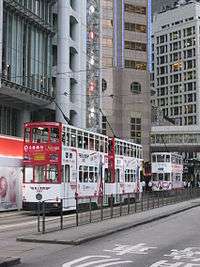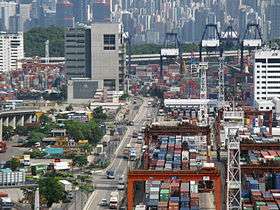Transport in Hong Kong
Hong Kong has a highly developed and sophisticated transport network, encompassing both public and private transport. Based on Hong Kong Government's Travel Characteristics Survey, over 90% of the daily journeys are on public transport, the highest rate in the world.[1] However, in 2014 the Transport Advisory Committee, which advises the Government on transportation issues, issued a report on the much worsened congestion problem in Hong Kong and pointed at the excessive growth of private cars during the past 10–15 years.[2]
| Economy of Hong Kong |
|---|
| Identity |
| Resources |
| Companies |
|
| Other Hong Kong topics |
|
|
| Hong Kong Portal |
The Octopus card, a smart electronic money payment system, was introduced in September 1997 to provide an alternative to the traditional banknotes and coins. Available for purchase in every stop of the Mass Transit Railway system, the Octopus card is a non-touch payment system which allows payment not only for public transport (such as trains, buses, trams, ferries and minibuses), but also at parking meters, convenience stores, supermarkets, fast-food restaurants and most vending machines.
Automated pedestrian transport
Escalators and moving pavements
Hong Kong Island is dominated by steep, hilly terrain, which required the development of unusual methods of transport up and down the slopes. In Central and Western district, there is an extensive system of zero-fare escalators and moving pavements. The Mid-levels Escalator is the longest outdoor covered escalator system in the world,[3] operating downhill until 10am for commuters going to work, and then operating uphill until midnight.[4]
The Mid-levels Escalator consists of twenty escalators and three moving pavements. It is 800 metres long,[5] and climbs 135 vertical metres.[6] Total travel time is approximately 25 minutes,[3] but most people walk while the escalator moves to shorten the travel time. Due to its vertical climb, the same distance is equivalent to several miles of zigzagging roads if travelled by car. Daily traffic exceeds 35,000 people. It has been operating since 1993 and cost HK$240,000,000 (US$30,000,000) to build.
A second Mid-Levels escalator set is planned in Sai Ying Pun: the Centre Street Escalator Link.
Rail transport
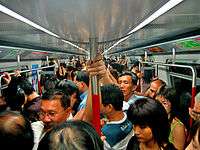
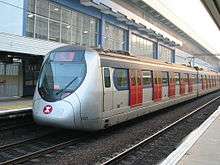
Hong Kong has an extensive railway network, and the Hong Kong Government has long established that the public transit system has "railway as its backbone". Public transport trains are operated by the MTR Corporation. The MTR operates the metro network within inner urban Hong Kong, Kowloon Peninsula and the northern part of Hong Kong Island with newly developed areas, Tsuen Wan, Tseung Kwan O, Tung Chung, Hong Kong Disneyland, the Hong Kong International Airport, the northeastern and northwestern parts of the New Territories. The Hong Kong Tramways operates a tram service exclusively on northern Hong Kong Island. The Peak Tram connects Central, Hong Kong's central business district, with Victoria Peak.
Mass Transit Railway
Opened in 1979, the system now includes 218.2 km (135.6 mi) of rail with 161 stations, including 93 railway stations and 68 light rail stops. The railway lines include the East Rail, Kwun Tong, Tsuen Wan, Island, Tung Chung, Tseung Kwan O, West Rail, Ma On Shan, South Island, the Airport Express and the Disneyland Resort lines. Nine of the lines provide general metro services, whereas the Airport Express provides a direct link from the Hong Kong International Airport into the city centre, and the Disneyland Resort Line exclusively takes passengers to and from Hong Kong Disneyland.
The Light Rail possesses many characteristics of a tramway, including running on streets with other traffic (at grade) on some of its tracks and providing services for the public in the northwestern New Territories, including Tuen Mun and Yuen Long.
All trains and most MTR stations are air-conditioned.
Tramways
The Hong Kong Tramways is the tram system run exclusively with double deckers.[7] The electric tram system was proposed in 1881;[8] however nobody was willing to invest in a system at the time. In August 1901, the Second Tramway Bill was introduced and passed into law as the 1902 Tramway Ordinance. Hong Kong Tramway Electric Company Limited, a British company, was authorised to take the responsibilities in construction and daily operation. In 1904, the tram system first got into service. It was soon taken over by another company, Electric Tranction Company of Hong Kong Limited and then the name was changed to Hong Kong Tramways Company Limited in 1910.
The rail system is 13 kilometres (8.1 mi) long,[9] with a total track length of 30 km (19 mi),[10] and it runs together with other vehicles on the street. Its operation relies on the 550V direct current (d.c.) from the overhead cables, on 3'6" gauge (1067 mm) tracks. The trams provide service to only parts of Hong Kong Island: they run on a double track along the northern coast of Hong Kong Island from Kennedy Town to Shau Kei Wan, with a single clockwise-running track of about 3 kilometres (1.9 mi) around Happy Valley Racecourse.
Funicular railways
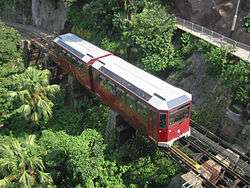
There are two funicular railway services in Hong Kong:
- The Peak Tram carries both tourists and residents to the upper levels of Hong Kong Island. It provides the most direct route to Victoria Peak and offers scenic views over Victoria Harbour and the skyscrapers of Hong Kong. It was inaugurated in 1888.
- The Ocean Express operates within the paid area of the Ocean Park theme park. It links two parts of the park, operating entirely in a tunnel. The ride is themed, and uses multimedia effects to simulate the feeling of travelling into the depths of the sea. It was opened in 2009.
Airport people-mover system
The Hong Kong International Airport Automated People Mover is a driverless people-mover system located within the Hong Kong International Airport in Chek Lap Kok. It operates in two "segments". For departures, the train runs from Terminal 2 to the East Hall to the West Hall. For arrivals, the train runs only from the West Hall to the East Hall, where all passengers must disembark for immigration, customs, and baggage claim. Operation of the first segment commenced in 1998, and the operation of the second segment commenced in early-2007.
There is another system between the terminals. There is also a travellator which can be used.
Cross-border trains
Inter-city train services crossing the Hong Kong-China boundary are known as Intercity Through Trains. They are jointly operated by Hong Kong's MTR Corporation and China Railway High-speed. Hung Hom Station (formerly called Kowloon Station) and West Kowloon Terminus are the stations in Hong Kong where passengers can catch these trains. With the exception of the XRL, passengers have to go through immigration and customs before boarding. There are currently four through train routes:
- Between Hong Kong and Beijing (Beijing-Kowloon Through Train)
- Between Hong Kong and Shanghai (Shanghai-Kowloon Through Train)
- Between Hong Kong and Guangzhou (Guangzhou-Kowloon Through Train)
- Between Hong Kong and Guangzhou (Guangzhou-Shenzhen-Hong Kong Express Rail Link) (XRL)
Road transport
Buses
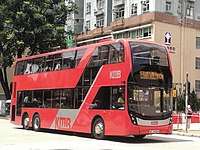
Bus services have a long history in Hong Kong. As of 2015, five companies operate franchised public bus services, each granted ten-year exclusive operating rights to the set of routes that they operate.[11] Franchise buses altogether carry about one-third of the total daily public transport market of around 12,000,000 passengers, with KMB having 67% of the franchised bus market share, CityBus with 16% and New World First Bus with 13%.[12] There are also a variety of non-franchised public buses services, including feeder bus services to railway stations operated by the railway companies, and residents' services for residential estates (particularly those in the New Territories).
The five franchised bus companies are:
- Kowloon Motor Bus Company (1933) Limited;
- Citybus Limited;
- Long Win Bus Company Limited;
- New World First Bus Services Limited; and
- New Lantao Bus Company (1973) Limited.
Founded in 1933, the Kowloon Motor Bus Company (1933) Limited (KMB) is one of the largest privately owned public bus operators in the world.[13] KMB's fleet consist of about 3,900 buses on 400 routes and a staff of over 12,000 people. In 1979, Citybus began its operations in Hong Kong with one double-decker, providing shuttle service for the Hong Kong dockyard. It later expanded into operating a residential bus route between City One, Shatin and Kowloon Tong MTR station. New World First Bus Services Limited was established in 1998, taking over China Motor Bus's franchise to provide bus services on Hong Kong Island together with Citybus. NWFB's owner company later bought Citybus, but the two companies have basically been operating independently.
Public light buses
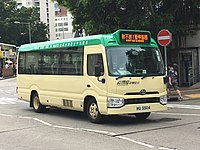
Public light buses (小巴) (widely referred to as minibuses, or sometimes maxicabs, a de facto share taxi) run the length and breadth of Hong Kong, through areas which the standard bus lines can not or do not reach as frequently, quickly or directly. Minibuses carry a maximum of 16 (19 for some routes since 2017) passengers; standing is not permitted.
The Hong Kong Transport Department (HKTD) allows and licenses the operation of two types of public light buses:
- green minibuses that have route numbers, stop at designated stops (many routes have hail and ride sections along which passengers can board and exit anywhere unless it is a no-stopping zone) and which have their fares, service and frequency regulated by the HKTD; and
- red minibuses that may or may not have regular routes, may or may not be numbered, may or may not have fixed stops and whose fares and service levels are not regulated by HKTD.[14]
Red minibuses often provide more convenient transport for passengers not served by green minibuses or other public buses, and are thus quite popular. Where green minibus drivers are paid fixed wages to drive their routes, red minibus drivers often rely on their fares for a living and thus are often seen to be more aggressive drivers. The prevalence of aggressive driving has resulted in the Transport Department making it mandatory for Hong Kong minibuses to be equipped with large read-out speedometers which allow passengers to track the speed at which minibus drivers operate. Currently, if minibuses exceed 80 km/h, the speedometer will sound an audible warning signal to the driver and passengers. If the minibus exceeds 100 km/h, the beeping will turn into a sustained tone.
The Transport Department has also regulated, after a series of minibus accidents, that all new minibuses brought into service after August 2005 must have seat belts installed, and passengers must use seat belts when they are provided.
Taxis
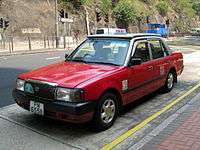
As of March 2016, there were 18,138 taxis in Hong Kong, operating in three distinct (but slightly overlapping) geographical areas, and distinguished by their colour. Of these, 15,250 are red urban taxis, 2,838 green New Territories taxis, and 50 blue Lantau taxis.[15] Every day, they serve 1,100,000, 207,900, and 1,400 passengers respectively. Taxis carry an average of 1,000,000 passengers each day, occupying about 12% of the daily patronage carried by all modes of public transport in Hong Kong.
Most of the taxis in Hong Kong run on LPG (liquified petroleum gas) to reduce emissions. In August 2000, a one-off grant was paid in cash to taxi owners who replaced their diesel taxi with an LPG one. Since August 2001, all newly purchased taxis run on LPG. By the end of 2003, over 99.8% of the taxi fleet in Hong Kong ran on LPG.[16]
Taxi fares are charged according to the taximeter; however, additional charges on the fare table may apply, such as road tolls and luggage fees. Urban taxis are the most expensive, while Lantau taxis are the cheapest. The standard of service among different kinds of taxis is mostly the same. The reason for having three types of taxis is to ensure service availability in less populated regions, as running in the urban centre is considered to be more profitable.
Private cars
As of May 2015, the Census and Statistics Department of Hong Kong reports that there are 504,798 licensed vehicles in Hong Kong.[17] In terms of private car ownership, the number of cars per capita is half that of Singapore and one-third that of Taiwan. However, the Transport Advisory Committee, which advises the government on transport policies, issued a report stating that the growth of private cars is too fast and must be contained so as to alleviate congestion problems of Hong Kong.[2] Private cars are most popular in newly developed areas such as New Territories and Lantau and areas near the border with mainland China, as there are fewer public transportation options, and more parking spaces compared to other areas of Hong Kong.
Most cars are right-hand drive models, from Japanese or European manufacturers. Almost all private vehicles in Hong Kong have dual airbags and are tested by JNCAP. Vehicles must also be maintained to a high standard, contrary to mainland China regulations. Hong Kong does not allow left-hand drive vehicles to be primarily registered in Hong Kong. However, Hong Kong registered vehicles may apply for secondary mainland Chinese registration plates, and these can be driven across the border to mainland China; likewise, left-hand drive cars seen in Hong Kong are usually primarily registered in mainland China and carry supplementary Hong Kong registration plates.
Cars are subjected to a first-time registration tax, which varies from 35% to over 100%, based on the size and value of the car. The level of vehicle taxation was increased by a law passed on 2 June 1982 to discourage private car ownership,[18] and also as an incentive to buy smaller, more efficient cars, as these have less tax levied on them. First-time registration tax was doubled, annual licensing fees were increased by 300%, and $0.70 duty fee was imposed on each litre of light oils.[19]
In addition to the heavy traffic at times, parking may be problematic. Due to high urban density, there are not many filling stations; petrol in Hong Kong averages around US$2.04 per litre, of which over half the cost is taxes.[20] It was suggested in the news that the government had deliberately impeded the use of new environmentally friendly diesel engines by allowing only light goods vehicles to be fuelled by diesel. While it cannot be determined why exactly the government does not allow private cars to be fuelled by diesel, it has been pointed out that the government does receive a tax that is 150% of the actual fuel cost. This is mostly to discourage car ownership for environmental reasons.[21]
There is a waiting list for local driving tests, while a full (private car) driving licence valid for ten years costs around US$115. Residents of Hong Kong holding licences issued by other Chinese authorities and some foreign countries can get a Hong Kong driving licence exempt from tests if they can adequately show that they obtained their licence while residing in the place concerned (common proofs are school transcripts or employer's documentation). Some private car owners, known as white card drivers, provide a taxi service for a nominal fee.
Bicycles
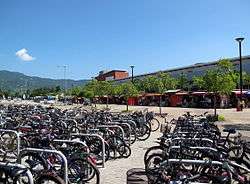
Cycling is a popular means of transport in many parts of the New Territories, where new towns such as Shatin, Tai Po and Sheung Shui have significant cycle track networks. In the auto congested urban areas of Hong Kong and Kowloon, cycling is less common, despite the relatively flat topography of populated areas, in part because it is government policy[22] not to support cycling as part of the transportation system. In 2011, MTR Corporation announced that bicycles were permitted to be taken on all MTR rail lines.[23]
Motorcycles
Motorcycles by the private users in Hong Kong urban districts are not as popular as in South East Asian countries like Vietnam. They are mostly used for commercial and business purposes.
Cross-border buses
A large number of buses leave various parts of Hong Kong (usually from side streets and hotel entrances) to various cities in the Pearl River Delta, Shenzhen and Guangzhou.
Maritime transport
Ferries
Internal routes
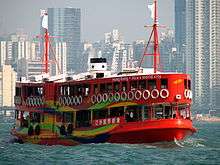
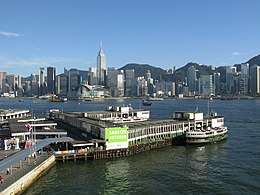
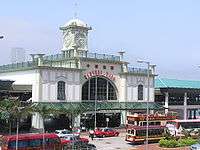
Most ferry services are provided by licensed ferry operators. As of September 2003, there were 27 regular licensed passenger ferry services operated by 11 licensees, serving outlying islands, new towns and inner-Victoria Harbour. Two of the routes operated by the Star Ferry are franchised. Additionally, 78 "kai-to" ferries are licensed to serve remote coastal settlements.
The following companies operate ferry services in Hong Kong:
- Central to Tsim Sha Tsui
- Wan Chai to Tsim Sha Tsui
- Harbour Tour (Circular between Tsim Sha Tsui, Central, Wan Chai, and Hung Hom)
- Central to Cheung Chau
- Central to Mui Wo
- Peng Chau, Mui Wo, Chi Ma Wan, and Cheung Chau
- North Point to Hung Hom
- North Point to Kowloon City
- Lamma Island to Central
- Central to Peng Chau
- Peng Chau to Hei Ling Chau
- Lamma Island(Sok Kwu Wan and Mo Tat) to Aberdeen
HKR International Limited:
- Discovery Bay Transportation Services – Discovery Bay to Central
Park Island Transport Company Ltd.:
Fortune Ferry (富裕小輪)
- North Point to Kwun Tong
- Tuen Mun to Tai O (via Tung Chung, Sha Lo Wan)
- Central to Hung Hom
Coral Sea Ferry (珊瑚海船務)
- Sai Wan Ho to Kwun Tong
- Sai Wan Ho to Lei Yue Mun (Sam Ka Tsuen)
- Lamma Island (Yung Chue Wan) to Aberdeen (Via: Pak Kok Tsuen)
- Po Toi to Stanley / Aberdeen
- Commuting routes for Tolo Harbour, Grass Island (known as:Tap Mun) and Long Harbour (known as: Tai Tan Hoi)
External routes
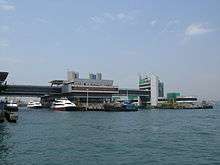
In Hong Kong, there are three piers that provides ferry services to Macau and cities in southern China:
- The Hong Kong-Macau Ferry Terminal
- The Hong Kong-China Ferry Terminal
- The Skypier (For Transitting Only)
Ferry services are provided by several different ferry companies at these piers.
Fastferry hydrofoil and catamaran service is available at all times of the week between Hong Kong and Macau.
TurboJet provides 24-hour services connecting Central and Macau at a frequency of up to every 15 to 30 minutes. It also provides these regular services:
- Hong Kong International Airport to Shenzhen Airport / Macau / Guangzhou (Nansha Ferry Port)
- Tsim Sha Tsui to Guangzhou
- Macau to Shenzhen Airport / Guangzhou
- Tsim Sha Tsui to Macau
Cotai Water Jet provides about 18-hour services connecting Central and Taipa or Outer Harbour, Macau at a frequency of up to every 30 to 60 minutes. It also provides these regular services:
- Hong Kong International Airport to Macau
- Tsim Sha Tsui to Macau
Chu Kong Passenger Transport (CKS) connects Hong Kong to cities in Guangdong province, including Zhuhai (Jiuzhou), Shenzhen (Shekou), Zhongshan (Zhongshan Kong), Lianhua Shan (Panyu), Jiangmen, Gongyi, Sanbu, Gaoming, Heshan, Humen, Nanhai, Shunde, Doumen.
Public transport statistics
The average amount of time people spend commuting with public transit in Hong Kong, for example to and from work, on a weekday is 73 min. 21% of public transit riders, ride for more than 2 hours every day. The average amount of time people wait at a stop or station for public transit is 14 min, while 19% of riders wait for over 20 minutes on average every day. The average distance people usually ride in a single trip with public transit is 11.2 km, while 31% travel for over 12 km in a single direction.[24]
Air transport
Aeroplanes
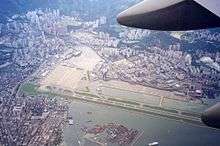
Hong Kong International Airport (HKG) is the primary airport for the territory and has been at Chep Lap Kok for 20 years. Over 100 airlines operate flights to international and Mainland China destinations from the airport; it is the main hub of flag carrier Cathay Pacific as well as Cathay Dragon, Air Hong Kong, and Hong Kong Airlines.[25] HKG is an important regional transhipment centre, passenger hub, and gateway for destinations in mainland China and the rest of Asia. It also handles the most air cargo traffic in the world.[26] With over 70 million passengers annually, it is the eighth busiest airport worldwide by passenger traffic.[27] HKG is constructed on an artificial island north of Lantau Island and was built to replace the overcrowded Kai Tak Airport in Kowloon Bay.[28] A third runway is also being constructed for the airport.
Ferry services link Hong Kong and Macau International Airport; there is an express service at the Hong Kong–Macau Ferry Terminal in which passengers can check in to flights at Macau Airport. Macau Airport has an "Express Link" service operating from the Hong Kong-Macau terminal, China Ferry Terminal, and Tuen Mun Ferry Terminal in which transiting passengers to Macau Airport are not processed through Macau customs.[29] In addition there is a bus service between Hong Kong and Shenzhen Bao'an International Airport in Shenzhen,[30] and people going to Shenzhen Airport may also board a ferry that goes to Fuyong Ferry Terminal at Shenzhen Airport.[31]
The majority of area private recreational aviation traffic, under the supervision of the Hong Kong Aviation Club (HKAC), goes in and out of Shek Kong Airfield in the New Territories.[32][33] The HKAC sent most of its aircraft to Shek Kong in 1994 after the hours for general aviation at Kai Tak Airport were sharply reduced, to two hours per morning, as of July 1 that year.[34] Usage of private aircraft at Shek Kong is restricted to weekends.[33]
Helicopters
Externally, frequent passenger helicopter flights to Macau are scheduled daily. There are also chartered services for the VIP and business community within Hong Kong.
Aerial lift transport
Cable cars
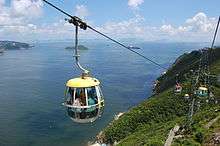
There are two cable car systems in Hong Kong:
- The Ngong Ping Cable Car is a 5.7 kilometres (3.5 mi) public cableway on Lantau Island. It links Tung Chung MTR station and Ngong Ping Terminal near Po Lin Monastery. It was opened on 18 September 2006.
- The Ocean Park theme park also possesses a 1.5 kilometres (0.93 mi) cable car system between Nam Long Shan Headland and Wong Chuk Hang. This was opened in 1977 and is inside the paid area of the Park.
Infrastructure
Ports and harbours
The port of Hong Kong has always been a key factor in the development and prosperity of the territory, which is strategically located on the Far East trade routes and is in the geographical centre of the fast-developing Asia-Pacific Basin. The sheltered harbour provides good access and a safe haven for vessels calling at the port from around the world.
The Victoria Harbour is one of the busiest ports in the world.[35] An average of 220,000 ships visit the harbour each year, including both oceanliners and river vessels, carrying both goods and passengers. The container port in Hong Kong is one of the busiest in the world.[36] The Kwai Chung Terminal operates 24 hours a day. Together with other facilities in Victoria Harbour, they handled more than 20 million twenty-foot equivalent units (TEU) in 2005.[37] Some 400 container liners serve Hong Kong weekly, connecting to over 500 destinations around the world.
Airports
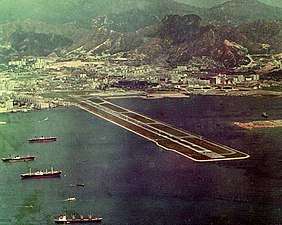
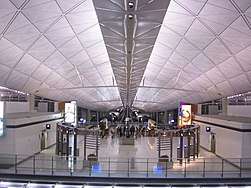
Hong Kong has a fully active international airport. The famous former Kai Tak International Airport retired in favour of the recently constructed Hong Kong International Airport, also known as Chek Lap Kok International Airport. The airport now serves as a transport hub for East Asia, and as the hub for Cathay Pacific, Dragonair, Hong Kong Express, Hong Kong Airlines (former CR Airways), and Air Hong Kong. Ferry services link the airport with several piers in Pearl River Delta, where immigrations and customs are exempted. Kai Tak airport was closed because of privacy reasons and also because of safety reasons; the aircraft came very close to the skyscrapers. Besides, the runway was surrounded by water.
HKIA’s network to China is also expanded by the opening of SkyPier in late-September 2003, offering millions in the PRD direct access to the airport. Passengers coming to SkyPier by high-speed ferries can board buses for onward flights while arriving air passengers can board ferries at the pier for their journeys back to the PRD. Passengers travelling in both directions can bypass custom and immigration formalities, which reduces transit time. Four ports – Shekou, Shenzhen, Macau and Humen (Dongguan) – were initially served. As of August 2007, SkyPier serves Shenzhen's Shekou and Fuyong, Dongguan's Humen, Macau, Zhongshan and Zhuhai. Moreover, passengers travelling from Shekou and Macau piers can even complete airline check-in procedures with participating airlines before boarding the ferries and go straight to the boarding gate for the connecting flight at HKIA. The provision of cross boundary coach and ferry services has transformed HKIA into an inter-modal transportation hub combining air, sea and land transport.
As of March 2009, the airport is the third busiest airport for passenger traffic,[38] and second-busiest airport for cargo traffic in the world.[39] It is popular with travellers – from 2001 to 2005 and 2007–2008 Hong Kong International Airport has been voted the World's Best Airport in an annual survey of several million passengers worldwide by Skytrax.
According to the Guinness World Records, the passenger terminal of the HKIA was the world's largest airport terminal upon opening, and is at present the world's third-largest airport terminal building, with a covered area of 550,000 m² and recently increased to 570,000 m².[40] The Airport Core Programme was the most expensive airport project in the world.[41]
Shek Kong Airfield, located near Yuen Long, is a military airfield for the People's Liberation Army, which is of limited operating capabilities due to surrounding terrain. The only aircraft operating on the airfield are PLA's Z-9 helicopters, which is the license-built version of the Eurocopter Dauphin.
Heliports
Hong Kong has three heliports. Shun Tak Heliport (ICAO: VHST) is located in the Hong Kong-Macau Ferry Terminal, by the Shun Tak Centre, in Sheung Wan, on Hong Kong Island. Another is located in southwest Kowloon, near Kowloon Station. The other is located inside Hong Kong International Airport.
Heli Express operates regular helicopter service between Macao Heliport (ICAO:VMMH) on the Macau Ferry Terminal in Macau and the Shun Tak Heliport. There are around 16 flights daily. Flights take approximately 20 minutes in the eight-seater aircraft.
There are also a number of helipads across the territory, including the roof of the Peninsula Hotel (which is the only rooftop helipad in Kowloon and Hong Kong Island, excluding the rooftop heliport of Shun Tak Centre and those in hospitals) and Cheung Chau Island, between Tung Wan Beach and Kwun Yam Beach.
Highways
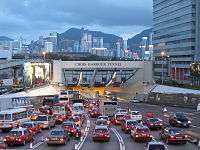
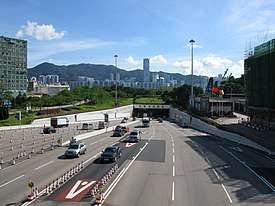
.jpg)
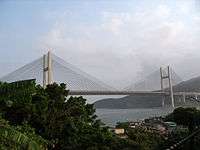
There are a total of 1,831 km of paved highways in Hong Kong. These roads are built to British standards with a maximum of four lanes with hard shoulders.
There are nine roads classified as highways in Hong Kong and were renumbered from 1 to 9 in 2004. Routes 1 to 3 are in a north–south direction (with each crossing one of the cross-harbour tunnels) while the others are in an east–west direction:
- Southern District ⇄ Causeway Bay ⇄ Tsim Sha Tsui ⇄ Mong Kok ⇄ Sha Tin
- Eastern District ⇄ Kwun Tong ⇄ Wong Tai Sin ⇄ Sha Tin
- Central & Western District ⇄ Tai Kok Tsui ⇄ Sham Shui Po ⇄ Kwai Tsing ⇄ Tsuen Wan ⇄ Yuen Long
- Eastern District ⇄ Causeway Bay ⇄ Wan Chai ⇄ Central & Western District
- Kowloon City ⇄ Wong Tai Sin ⇄ Sham Shui Po ⇄ Kwai Tsing ⇄ Tsuen Wan
- Tseung Kwan O ⇄ Kwun Tong ⇄ Wong Tai Sin ⇄ Sham Shui Po ⇄ Kwai Tsing
- Sha Tin <> Kwai Tsing ⇄ Lantau Island North ⇄ Tung Chung ⇄ Airport
- Circular Route linking the whole New Territories (Sha Tin, Tai Po, Northern District, Yuen Long, Tuen Mun, Tsuen Wan)
- Tuen Mun ⇄ Nam Tei (Divided from Route 9) ⇄ Ha Tsuen ⇄ Deep Bay ⇄ Shenzhen Bay Bridge ⇄ Shenzhen Bay Border Crossing ⇄ Mainland China
Route 6 is a proposed highway, and is now under construction.
There are 120 CCTV cameras monitoring traffic on these highways and connecting roads which are available on-demand (Now TV) and on the Transport Department's website.
Highways in Hong Kong use two types of barrier system for divided highways. Older roads use metal guard rails and newer roads use the British Concrete step barrier.
All signage on highways and roads in Hong Kong are bilingual (traditional Chinese below and English above). Street signs use black text on a white background. Highway and directional signage are white lettering on blue or green background.
Bridges and tunnels
There are 12 major vehicular tunnels in Hong Kong. They include three cross-harbour tunnels and nine road tunnels.
Other road tunnels and bridges which are proposed or under construction are:
- Central Kowloon Route
- Cross Bay Link
- Tseung Kwan O – Lam Tin Tunnel
- Trunk Road T2
- Tuen Mun–Chek Lap Kok Link (under construction)
Bus lanes
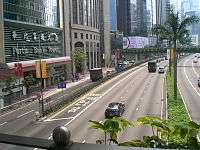
There are approximately 22 km of bus priority lanes in Hong Kong.
Bus termini
There are 298 bus termini in Hong Kong.[42] Notable examples include:
Pedestrian infrastructure
Pedestrian infrastructure in Hong Kong includes:
Ports of entry
This is a list of ports of entry (i.e. immigration control points) in Hong Kong.
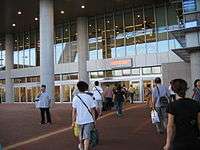
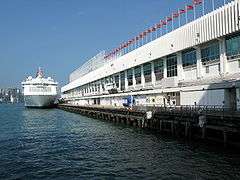
- Air
- Hong Kong International Airport
- Heliport at the Hong Kong-Macau Ferry Terminal
- Land
- Lo Wu Control Point
- Lok Ma Chau Control Point
- Lok Ma Chau Spur Line
- Man Kam To Control Point
- Sha Tau Kok Control Point
- Shenzhen Bay Control Point
- Railway
- Hung Hom Terminus (also called Kowloon Terminus)
- West Kowloon Terminus
- Sea
- Hong Kong-Macau Ferry Terminal
- Hong Kong-China Ferry Terminal
- Ocean Terminal
- Kai Tak Cruise Terminal
- Tuen Mun Ferry Pier
- Western Immigration Anchorage
- Eastern Immigration Anchorage
- Tuen Mun Immigration Anchorage
See also
References
- Lam, William H.K. [2003] (2003). Advanced Modeling for Transit Operations and Service Planning. Elsevier publishing. ISBN 0-08-044206-4
- http://www.thb.gov.hk/eng/boards/transport/land/Full_Eng_C_cover.pdf
- Boland, Rory. "Hong Kong's Central-Mid Levels Escalator – The Longest in the World". About.com. Retrieved 19 July 2009.
- Jahnke, Morgen (26 February 2007). "The Central – Mid-Levels Escalator". Interesting Thing of the Day. Retrieved 25 July 2009.
- Dennis, Bernard (2003). China: the business traveller's handbook (1 ed.). Interlink Books. p. 214. ISBN 1-56656-495-6.
- Lim, William S. W. (2007). Asian Alterity: With Special Reference to Architecture + Urbanism Through the Lens of Cultural Studies. forewords by Andrew Lee, Leong Teng Wui, Linda Lim & Lim Teck Ghee. World Scientific Publishing. p. 138. ISBN 981-270-771-9.
- Fallon, Stephen (January 2006). "Tram". Hong Kong & Macau (12th ed.). Lonely Planet Publications. p. 302. ISBN 1-74059-843-1.
- Dimitriou, Harry T.; Alison H. S. Cook (1998). Land-Use/Transport Planning in Hong Kong: The End of an Era: A Review of Principles and Practices. Ashgate Publishing. p. 110. ISBN 1-84014-171-9.
- Bondada, Murthy V. A. (2000). Urban Public Transportation Systems: Implementing Efficient Urban Transit Systems and Enhancing Transit Usage: Proceedings of the First International Conference: March 21–25, 1999, Miami, Florida, USA. American Society of Civil Engineers. p. 240. ISBN 0-7844-0498-4.
- Cheng, Joseph Y. S.; Yushuo Zheng, Hungyi Chen (1986). Hong Kong in Transition. Hong Kong: Oxford University Press. p. 379. ISBN 0-19-584061-5.
- http://www.td.gov.hk/en/publications_and_press_releases/press_releases/transport_department/index_t_id_2251.html
- "Hong Kong Digest of Statistics"
- "Sybase Success Story: Kowloon Motor Bus Company". 21 April 2009. Retrieved 19 July 2009.
- HKTD Public Light Bus Policy Archived 4 January 2007 at the Wayback Machine. Accessed 11 December 2006
- Hong Kong: The Facts – Transport (PDF), May 2016, retrieved 30 March 2018
- Yeung, Yue-man (2008). The First Decade: The Hong Kong SAR in Retrospective and Introspective Perspectives. Chinese University Press. p. 340. ISBN 962-996-357-4.
- "Transport, Communications and Tourism" (PDF). Census and Statistics Department. Retrieved June 2015. Check date values in:
|accessdate=(help) - Legco doubts on car curbs, South China Morning Post, 3 June 1982
- Michael Chugani, Legco doubts on car curbs, South China Morning Post, 20 May 1982
- "Caltex Singapore – Why do prices rise and fall?". Caltex. Retrieved 20 July 2009.
- Mottershead, Terri. [2004] (2004). Sustainable Development in Hong Kong. HK University. ISBN 962-209-491-0
- HK Cycling Alliance
- MTR Announce Bicycles permitted on all lines
- "Hong Kong Public Transportation Statistics". Global Public Transit Index by Moovit. Retrieved 19 June 2017.

- "Welcome to Hong Kong International Airport". Airport Authority Hong Kong. Retrieved 20 November 2017.
- NY/NJ Port Authority Airport Traffic 2017, p. 58.
- NY/NJ Port Authority Airport Traffic 2017, p. 32.
- Landler, Mark (6 July 1998). "A 6-Hour Move, and Landing in Hong Kong Loses a Thrill". The New York Times. New York. Retrieved 1 March 2018.
- "Express Link Service." Macau International Airport. Retrieved on May 9, 2018. "The Express Link Check-In Counter at Hong Kong Shun Tak Ferry Terminal" and "Service is available at the following ferry terminals: •HK Macau Ferry Terminal (G02 Shun Tak Centre) •China Ferry Terminal, Kowloon •Tuen Mun Ferry Terminal (TurboJET Service Counter, G/F)"
- "HK and Macau Traffic > Bus ." Shenzhen Bao'an International Airport. Retrieved on May 9, 2018.
- "Passenger Ship." Shenzhen Bao'an International Airport. Retrieved on May 9, 2018.
- Mola, Roger A. (September 2003). "Last Stand at Kai Tak". Airspace Magazine. Retrieved 21 April 2018.
Because Chek Lap Kok is closed to most private pilots, the club now operates its six Cessnas and an aerobatic Slingsby Firefly from nearby Shek Kong military airfield, but only on weekends, and always subject to the goodwill of the People’s Liberation Army.
- "High-flyers have licence to thrill". South China Morning Post. 26 June 2010. Retrieved 21 April 2018.
For anyone who has ever dreamt of flying, the first step to getting your wings is to join the Hong Kong Aviation Club (HKAC), the city's only flight training centre.[...]The Shek Kong Airfield is used by the People's Liberation Army during the week, with permission given to the club to use it during weekends.
- "Aviation club takes off for Sek Kong". scmp.com. South China Morning Post. 22 August 1994. Retrieved 18 April 2018.
- Fischer, Umbert (6 October 2006). "Victoria Harbour Hong Kong, the world's most busy sea port". Excelloz.com. Retrieved 26 June 2009.
- L. Hau Lee, Chung-Yee Lee (2007). Building supply chain excellence in emerging economies. New York: Springer. p. 204. ISBN 0-387-38428-6.
- Stopford, Martin (February 2009). Maritime Economics E3 (3rd ed.). Routledge. p. 560. ISBN 978-0-415-27558-3.
- "Year to date Passenger Traffic – March 2009". Airports Council International. 12 June 2009. Retrieved 20 July 2009.
- "Year to date Cargo Traffic – March 2009". Airports Council International. 12 June 2009. Retrieved 20 July 2009.
- "The 'dragon' unveiled: Beijing's T3 starts operations". Beijing 2008 Olympic Games. 28 February 2008. Archived from the original on 11 September 2011. Retrieved 28 July 2009.
- Owen, Bernie; Raynor Shaw (2008). Hong Kong Landscapes: Shaping the Barren Rock. Hong Kong: Hong Kong University Press. p. 169. ISBN 962-209-847-9.
- "立法會十七題:為專營巴士公司員工提供配套設施". www.info.gov.hk. Retrieved 9 March 2020.
